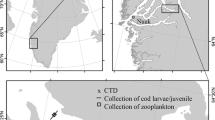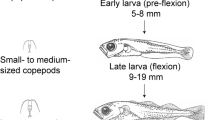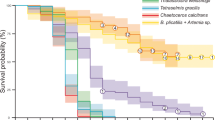Abstract
Response of mesocosm-reared cod (Gadus morhua L.) larvae to different feeding conditions was investigated in 1988 in two mesocosms: a large basin and a smaller bag enclosure within the basin. The basin was filled with seawater, and a community of naturally occurring plankton developed. Plankton concentrations were monitored, and cod larvae stocked in the enclosures were sampled for determination of growth, survival, and gut content. In the bag, insufficient amounts of energetically favourable prey, as copepod nauplii, led to non-selective ingestion of plankton from a broad range of sizes, including considerable amounts of protozoans (tintinnid and oligotrich ciliates). Growth of larvae from the bag was low, with daily specific growth rates (SGR) less than 2.8% the first 3 wk post-hatch. This was followd by rapid increase of SGR to 21.7%, which coincided with a large increase in availability of copepod nauplii. In the basin, high nauplii concentrations led to SGR of 13.7 to 21.7% from onset of feeding to 16 d post-hatch, respectively. Under such conditions, the larvae were highly selective feeders. At 3 wk post-hatch, survival was 36.7 and 38.3% in the basin and bag enclosure, respectively. To cope with variations in the feeding conditions, the cod larvae were shown to be opportunists when nauplii were scarce, and included plankton from several trophic levels in their diet. When nauplii were abundant, cod larvae realized their high potential for growth. Both opportunism and realization of a high growth potential may enhance survival of the larvae.
Similar content being viewed by others
Literature cited
Andersen, P., Sørensen, H. M. (1986). Population dynamics and trophic coupling in pelagic microorganisms in eutrophic coastal waters. Mar. Ecol. Prog. Ser. 33: 99–109
Bainbridge, V., McKay, B. J. (1968) The feeding of cod and redfish larvae. Spec. Publs. int. Commn NW Atlant. Fish. 7: 187–217
Berg, J. (1979). Discussion of methods of investigating the food of fishes, with reference to a preliminary study of the prey of Gobiusculus flavescens (Gobiidae). Mar. Biol. 50: 263–273
Beyer, J. E., Laurence, G. C. (1981). Aspects of stochasticity in modelling growth and survival of clupeoid fish larvae. Rapp. P.-v. Réun. Cons. int. Explor. Mer. 178: 17–23
Blom, G., Otterå, H., Svåsand, T., Kristiansen, T. S., Serigstad, B. (1991). The relationship between feeding conditions and production of cod fry (Gadus morhua L.) in a semi-enclosed marine ecosystem in western Norway, illustrated by use of a consumption model. Int. Counc. Explor. Sea (ICES) mar. Sci. Symp. 192: 176–189
Brewer, G. D., Kleppel, G. S. (1986). Diel vertical distribution of fish larvae and their prey in nearshore waters of southern California, Mar. Ecol. Prog. Ser. 27: 217–226
Buckley, L. J., Dillmann, D. W. (1982). Nitrogen utilization by larval summer flounder Paralichthys dentatus (Linnaeus). J. exp. mar. Biol. Ecol. 59: 243–256
Böttger, R., Schnack, D. (1986). On the effect of formaldehyde fixation on the dry weight of copepods. Meeresforsch. 31: 141–152
Capriulo, G. M. (1982). Feeding of field collected tintinnid microzooplankton on natural food. Mar. Biol. 71: 73–86
Capriulo, G. M., Carpenter, E. J. (1983). Abundance, species composition and feeding impact of tintinnid micro-zooplankton in central Long Island sound. Mar. Ecol. Prog. Ser. 10: 277–288
Chen, W., Govoni, J., Warlen, S. M. (1992). Comparison of feeding and growth of larval round herring Etrumeus teres and gulf menhaden Brevoortia patrinus. Fish Bull. U.S. 90: 183–189
Cetta, C. M., Capuzzo, J. M. (1982). Physiological and biochemical aspects of embryonic and larval development of the winter flounder Pseudopleuronectes mericanus. Mar. Biol. 71: 327–337
Checkley, D. M. Jr., (1982). Selective feeding by Atlantic herring (Clupea harengus) larvae on zooplankton in natural assemblages. Mar. Ecol. Prog. Ser. 9: 245–253
Chisholm, L. A., Roff, J. C. (1990). Size-weight relationships and biomass of tropical neritic copeptods off Kingston, Jamaica. Mar. Biol. 106: 71–77
Cousin, J. C. B., Baudin-Laurencin, F., Gabaudan, J. (1987). Ontogeny of enzymatic activities in fed and fasting turbot, Scophthalmus maximus L. J. Fish. Biol. 30: 15–33
Courtois, R., Dodson, J. J. (1986). Régime alimentaire et principaux facteurs influençant l'alimentation des larves de capelan (Mallotus villotus), d'éperlan (Osmerus mordax) et de hareng (Clupea harengus harengus) dans un estuaire partiellement mélangé. Can. J. Fish. aquat. Sciences 43: 968–979
Dale, T. (1987). Oil pollution and plankton dynamics. II. Abundance pattern of ciliates inside and outside enclosures and the responses of ciliates to oil during the 1980 spring bloom in Lindåspollene, Norway. Sarsia 72: 197–202
Dale, T., Burkill, P. H. (1982). “Live counting” — a quick and simple technique for enumerating pelagic ciliates. Annls Inst. océanogr., Paris 58: 267–276
Danielsen, D. S., Haugen, A. S., Øiestad, V. (1990). Survival and growth of turbot (Scophthalmus maximus L.) in a land-situated mesocosm. Flødevigen rapportser. 2: 11–45
Deplano, M., Diaz, J. P.. Connes, R., Kentouri-Divanach, M., Cavalier, F. (1991). Appearance of lipid-absorption capacities in larvae of the sea bass Dicentrarchus labrax during transition to the exotrophic phase. Mar. Biol. 108: 361–371
Ellertsen, B., Fossum, P., Solemdal, P., Sundby, S. (1989). Relation between temperature and survival of eggs and first-feeding larvae of northeast Artic cod (Gadus morhua L.). Rapp. P.-v. Réun. Cons. int. Explor. Mer. 191: 209–219
Ellertsen, B., Fossum, P., Solemdal, P., Sundby, S., Tilseth, S. (1984). A case study on the distribution of cod larvae and availability of prey organisms in relation to physical processes in Lofoten. Flødevigen rapportser 1: 453–477
Ellis, A. E. (1988). Ontogeny of the immune system in teleost fish. In: Ellis, D. A. (ed.) Fish vaccination. Academic Press, London, p. 20–31
Frank, K. T., Leggett, W. C. (1986). Effect of prey abundance and size on the growth and survival of larval fish: an experimental study employing large volume enclosures. Mar. Ecol. Prog. Ser. 34: 11–22
Gaarder, K. R. (1938). Phytoplankton studies from the Tromsø district 1930–1931. Tromsø Mus. Årshefte 55: 1–159
Gadomski, D. M., Boehlert, G. W. (1984). Feeding ecology of pelagic larvae of English sole Parophrys vetulus and butter sole Isopsetta isolepis off the Oregon coast. Mar. Ecol. Prog. Ser. 20: 1–20
Gamble, J. C., MacLachlan, P., Nicoll, N. T., Baxter, I. G. (1981). Growth and feeding of Atlantic herring larvae reared in large plastic enclosures. Rapp. P.-v. Réun. Cons. int. Explor. Mer 178: 121–134
Gilron, G. L., Lynn, D. H. (1989). Assuming 50% cell occupancy of the lorica overestimates tintinnine ciliate biomass. Mar. Biol. 103: 413–416
Govoni, J. J., Hoss, D. E., Chester, A. J. (1983). Comparative feeding of three species of larval fishes in the northern Gulf of Mexico: Brevoortia patronus. Leiostomus xanthurus, and Micropongonias undulatus. Mar. Ecol. Prog. Ser. 13: 189–199
Govoni, J. J., Ortner, P. B., Al-Yamani, F., Hill, L. C. (1986). Selective feeding of spot, Leiostomus xanthurus, and Atlantic croaker, Micropogonias undulatus, larvae in the northern Gulf of Mexico. Mar. Ecol. Prog. Ser. 28: 175–183
Hernroth, L. (1983). Marine pelagic rotifers and tintinnids — important trophic links in the spring plankton community of the Gullmar Fjord, Sweden, J. Plankton Res. 5: 835–846
Holm, J. C., Møller, D. (1984). Growth and prey selection by atlantic salmon yearlings reared on live freshwater zooplankton. Aquaculture, Amsterdam 43: 401–412
Houde, E. D. (1975). Effects of stocking density and food density on survival, growth and yield of laboratory-reared larvae of sea bream Archosargus rhomboidalis (L.) (Sparidae). J. Fish. Biol. 7: 115–127
Houde, E. D., Schekter, R. C. (1980). Feeding by marine fish larvae: developmental and functional responses. Envir. Biol. Fish. 5: 315–334
Houde, E. D., Schekter, R. C. (1981). Growth rates, rations and cohort consumption of marine fish larvae in relation to prey concentrations. Rapp. Rapp. P.-v. Réun. Cons. int. Explor. Mer 178: 441–453
Houde, E. D., Schekter, R. C. (1983). Oxygen uptake and comparative energetics among eggs and larvae of three subtropical marine fishes. Mar. Biol. 72: 283–293
Hunter, J. R. (1980). The feeding behavior and ecology of marine fish larvae. In: Bardach, J. E., Magnuson, J. J. May, R. C., Reinhart, J. M. (eds.) Fish behavior and its use in the capture and culture of fishes. ICLARM Conf. Proc., Vol. 5. International Center for Living Aquatic Resources Management, Manila, p. 287–330
Huse, I., Jensen, P. A. (1983) Asimple and inexpensive spawning and egg collection system for fish with pelagic eggs. Aquacultural Engineering 2: 165–172
Incze, L. S., Ortner, P. B., Schumacher, J. D. (1990). Microzooplankton, vertical mixing and advection in a larval fish patch. J. Plankton Res. 12: 365–379
Jahn, A. E., Gadomski, D. M., Sowby, M. L. (1988). On the role of food-seeking in the suprabenthic habit of larval white croaker. Genvonemus lineatus (Pisces: Sciaenidae). Fish. Bull. U.S. 86: 251–262
Kauffman, T. A., Lindsay, J., Leithiser, R. (1981). Vertical distribution and food selection of larval atherinids. Rapp. P.-v. Réun. Cons. int. Explor. Mer 178: 342–343
Kjørsvik, E., van der Meeren, T., Kryvi, H., Arnfinnson, J., Kvenseth, P. G. (1991). Early development of the digestive tract of cod larvae, Gadus morhua L., during start-feeding and starvation. J. Fish. Biol. 38: 1–15
Kuhlman, D., Quantz, G., Witt, U. (1981). Rearing of turbot larvae (Scophthalmus maximus L.) on cultured food organisms and postmetamorphosis growth on natural and artificial food. Aquaculture, Amsterdam 23: 183–196
Kvenseth, P. G., Øiestad, V. (1984). Large-scale rearing of cod fry on natural food production in an enclosed pond. Flødevigen rapportser. 1: 645–655
Lasker, R. (1981). Factors contributing to variable recruitment of the northern anchovy (Engraulis mordax) in the California current: contrasting years, 1975 through 1978. Rapp. P.-v. Réun. Cons. int. Explor. Mer 178: 375–388
Lasker, R., Zweifel, R. J. (1978). Growth and survival of first-feeding northern anchovy larvae (Engraulis mordax) in patches containing different proportions of large and small prey. In: Steele, J. H. (ed.) Spatial pattern in plankton communities. Plenum Publ. Corp. New York, p. 329–354
Last, J. M. (1978a). The food of four species of pleuronectiform larvae in the eastern English Channel and southern North Sea. Mar. Biol. 45: 359–368
Last, J. M. (1978b). The food of three species of gadoid larvae in the eastern English Channel and southern North Sea. Mar. Biol. 48: 377–386
Laurence, G. C. (1977). A bioenergetic model for the analysis of feeding and survival potential of winter flounder, Pseudopleuronectes americanus, larvae during the period from hatching to metamorphosis. Fish. Bull. U.S. 75: 529–546
Lie, U., Magnesen, T., Tunberg, B., Aksnes, D. (1983). Preliminary studies on the vertical distribution of size-fractions in the zooplankton community in Lindåspollene, western Norway. Sarsia 68: 65–80
Lutter, S., Taasen, J. P., Hopkins, C. C. E., Smetacek, V. (1989). Phytoplankton dynamics and sedimentation processes during spring and summer in Balsbjord, northern Norway, Polar Biol. 10: 113–124
Marak, R. R. (1960). Food habits of larval cod, haddock, and coalfish in the Gulf of Maine and Georges Bank area. J. cons. perm. int. Explor. Mer 25: 147–157
May, R. C. (1974). Larval mortality in marine fishes and the critical period concept. In: Blaxter, J. H. S. (ed.) The early life history of fish. Springer, New York, p. 3–19
McGurk, M. D. (1986). Natural mortality of marine pelagic fish eggs and larvae: role of spatial patchiness. Mar. Biol. Prog. Ser. 34: 227–242
Mittelbach, G. G. (1981). Foraging efficiency, and body size: a study of optimal diet and habitat use by bluegills. Ecology 62: 1370–1386
Murdoch, R. C. (1990). Diet of hoki larvae (Macruronus novaezelandiae) off Westland, New Zealand, N.Z. Jl. mar. Freshwat. Res. 24: 519–527
Naas, K. E., van der Meeren, T., Aksnes, D. L. (1991). Plankton succession and larval responses to manipulations in a marine basin for larval fish rearing. Mar. Ecol. Prog. Ser. 74: 161–173
Ohguchi, O. (1981). Prey density and selection against oddity by three-spined sticklebacks. Z. Tierpsychol. (Beih.) 23: 1–79
Omori, M., Hamner, W. M. (1982). Patchy distribution of zooplankton: behavior, population assessment and sampling problems. Mar. Biol. 72: 193–200
Omori, M., Ikeda, T. (1984). Methods in marine zooplankton ecology. John Wiley & Sons, New York
Owen, R. C. (1981). Microscale plankton patchiness in the larval anchovy environment. Rapp. P.-v. Réun. Cons. int. Explor. Mer 178: 364–368
Pedersen, B. H., Uglestad, I., Hjelmeland, K. (1990). Effects of a transitory, low food supply in the early life of larval herring (Clupea harengus) on mortality, growth and digestive capacity. Mar. Biol. 107: 61–66
Pedersen, T., Elliassen, J. E., Eilertsen, H. C., Tande, K. S., Olsen, R. E. (1989). Feeding, growth, lipid composition, and survival of larval cod (Gadus morhua L.) in relation to environmental conditions in an enclosure at 70° in northern Norway. Rapp. P.-v. Réun. Cons. int. Explor. Mer 191: 409–420
Peterson, I., Wroblewski, J. S. (1984). Mortality rate of fishes in the pelagic ecosystem. Can. J. Fish. aquat. Sciences 41: 1117–1120
Richter, K. E. (1985). Acoustic determination of small-scale distribution of individual zooplankters and zooplankton aggregations. Deep-Sea Res. 32: 163–182
Rognerud, C. (1887). Hatching cod in Norway, Bull. U.S. Fish Commun 8: 113–119
Rosenberg, A. A., Haugen, A. S. (1982). Individual growth and size selective mortality of larval turbot (Scophthalmus maximus) reared in enclosures. Mar. Biol. 72: 73–77
Solemdal, P. (1981). Enclosure studies. Rapp. P.-v. Réun. Cons. int. Explor. Mer 178: 117–120
Stepien, W. P. (1976). Feeding of laboratory-reared larvae of the sea-bream Archosargus rhomboidalis (Sparidae). Mar. Biol. 38: 1–16
Sundby, S., Bjørke, H., Soldal, A. V., Olsen, S. (1989). Mortality rates during the early life stages and year-class strength of the North-east arctic cod (Gadus morhua L.). Rapp. P.-v. Réun. Cons. int. Explor. Mer 191: 351–358
Sysoeva, T. K., Degtereva, A. A. (1965). The relation between the feeding of cod larvae and pelagic fry and the distribution and abundance of their principal food organisms. Spec. Publs int. Commn NW Atlant. Fish. 6: 411–416
Taggart, C. T., Drinkwater, K. F., Frank, K. T., McRuer, J., LaRouche, P. (1989). Larval fish community structure, and physical dynamics at a tidal front. Rapp. P.-v. réun. Cons. int. Explor. Mer 191: 184–194
Tilseth, S. (1990). New marine fish species for cold-water farming. Aquaculture, Amsterdam 85: 235–245
van der Meeren, T. (1991a). Algae as first food for cod larvae, Gadus morhua L.: filter feeding or ingestion by accident? J. Fish. Biol. 39: 225–237
van der Meeren, T. (1991b). Selective feeding and prediction of food consumption in turbot larvae (Scopthalmus maximus L.) reared on the rotifer Brachionus plicatilis and natural zooplankton. Aquaculture, Amsterdam 93: 35–55
Verity, P. G. (1987). Abundance, community composition, size distribution, and production rates of tintinnids in Narragansett Bay, Rhode Island. Estuar. cstl Shelf Sci. 24: 671–690
Werner, R. G., Blaxter, J. H. S. (1980). Growth and survival of larval herring (Clupea harengus) in relation to prey density. Can. J. Fish. aquat. Sciences 37: 1063–1069
Werner, E. E., Hall, D. J. (1974). Optimal foraging and the selection of prey by the Bluegill sunfish (Lepomis macrochirus). Ecology 55: 1042–1052
Wyatt, T. (1972). Some effects of food density on the growth and behaviour of plaice larvae. Mar. Biol. 14: 210–216
Zweifel, J. R., Lasker, R. (1976). Prehatch and posthatch growth of fishes — a general model. Fish. Bull. U.S. 74: 609–621
Øiestad, V. (1983). Growth and survival of herring larvae and fry (Clupea harengus L.) exposed to different feeding regimes in experimental ecosystems: outdoor basin and plastic bags. Ph.D. thesis, University of Bergen, Bergen
Øiestad, V. (1985). Predation of fish larvae as a regulatory force, illustrated in mesocosm studies with large groups of larve. N. Atlant. Fish. Orgn (NAFO) Scient. Coun. Stud. 8: 25–32
Øiestad, V. (1990). Specific application of meso- and macrocosms for solving problems in fisheries research. In: Lalli, C. M. (ed.) Enclosed experimetnal marine ecosystems: a review and recommendations. Springer-Verlag, Berlin, p. 136–154
Øiestad, V., Kvenseth, P. G., Folkvord, A. (1985). Mass production of Atlantic cod juveniles Gadus morhua in a Norwegian saltwater pond. Trans. Am. Fish. Soc. 114: 590–595
Author information
Authors and Affiliations
Additional information
Communicated by T.M. Fenchel, Helsingør
Rights and permissions
About this article
Cite this article
van der Meeren, T., Næss, T. How does cod (Gadus morhua) cope with variability in feeding conditions during early larval stages?. Marine Biology 116, 637–647 (1993). https://doi.org/10.1007/BF00355482
Received:
Accepted:
Issue Date:
DOI: https://doi.org/10.1007/BF00355482




